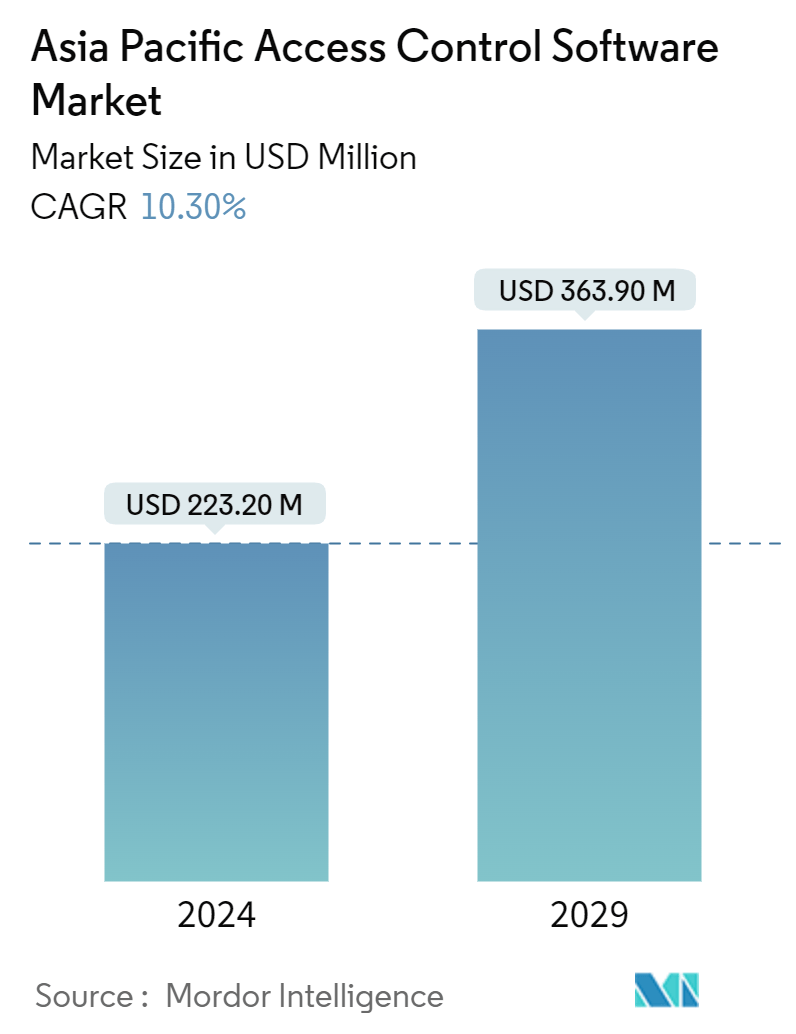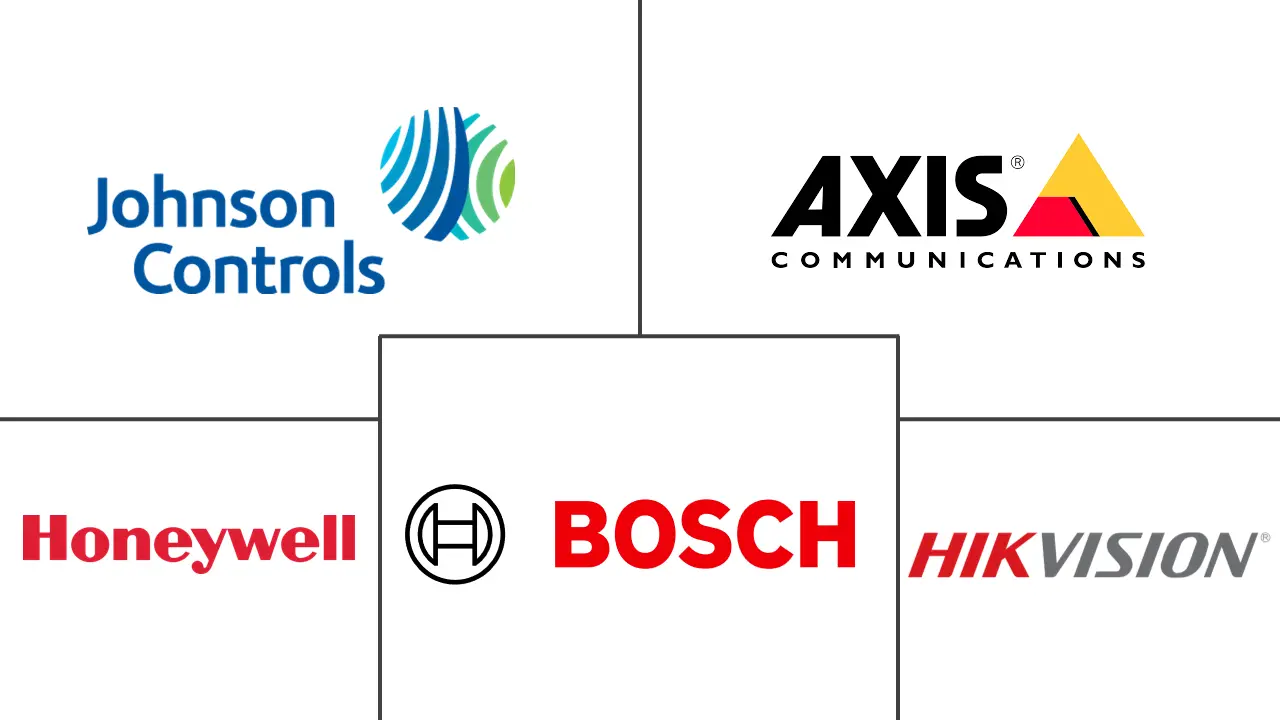Market Size of Asia Pacific Access Control Software Industry

| Study Period | 2019 - 2029 |
| Base Year For Estimation | 2022 |
| Market Size (2024) | USD 223.20 Million |
| Market Size (2029) | USD 363.90 Million |
| CAGR (2024 - 2029) | 10.30 % |
| Market Concentration | Low |
Major Players
*Disclaimer: Major Players sorted in no particular order |
Asia Pacific Access Control Software Market Analysis
The Asia Pacific Access Control Software Market size is estimated at USD 223.20 million in 2024, and is expected to reach USD 363.90 million by 2029, growing at a CAGR of 10.30% during the forecast period (2024-2029).
In the last few decades, the commercial and industrial sectors of Asia-Pacific witnessed remarkable growth. Countries like China, India, and Taiwan, among others, opening the market for global firms, have significantly driven investments in the region as businesses continue to flock to the market to leverage the availability of low-cost workforce and the presence of a large consumer market. As a result, the number of commercial and industrial establishments in the region has grown significantly, creating opportunities in the market studied.
Increased digitization across Asia-Pacific and a desire for improvement in business processes have increased the adoption of various digital technologies, leading to a significant spike in the amount of data generated. As some of the data related to business operations are highly critical for businesses, there is a need to ensure optimum security of the data, which is driving the attention of companies toward advanced solutions, such as access control software, as it ensures the right person has access to right place both in the office and the IT system.
In Asia-Pacific, countries like India, China, and the Philippines have witnessed notable growth in IT-related businesses. For instance, India emerged as a significant software outsourcing hub. According to NASSCOM, in FY 2023, the revenue of the technology industry (including hardware) in India was estimated to cross the evaluation of about USD 245 billion, reporting an 8.4% Y-o-Y growth. Such trends are anticipated to drive the demand for access control solutions in offices belonging to IT firms and other related enterprises.
Furthermore, the market share of access control solutions is also anticipated to witness notable growth in the residential sector of the region as the instances of house breaches, theft, and trespassing remain significant across various countries. The growing proliferation of smart home devices is also making consumers more accepting of advanced home security solutions, creating a favorable outlook for the market studied.
However, in Asia-Pacific, the concentration of small and medium enterprises is relatively higher in developed regions. As a result, the price sensitivity of the consumers in the commercial segment is high. Low economic growth across several countries also restraints the adoption of access control software solutions in the residential segment. Furthermore, a lower awareness about the risk of cyberattacks and a lack of regulations related to cybersecurity issues also challenge the market's growth in the region.
Asia-Pacific was significantly impacted by the pandemic. As a result, widespread lockdowns were imposed across major countries, leading to businesses closing their offices and shifting to a remote working model, which slowed down the growth of the market in the region. However, a major positive influence of the pandemic was the growth in awareness about digital technologies. The pandemic significantly enhanced the exposure to intelligent technologies, which may drive the growth of the market studied during the forecast period.
Asia Pacific Access Control Software Industry Segmentation
Access control software is an essential element of security that governs who is allowed access to specific information, applications, and data sources. It allows organizations to control access to gates, doors, and other areas wherein authorization is required, ensuring that only authorized personnel are permitted in secure locations. It also helps safeguard sensitive information, such as information of customers and intellectual property, from being stolen by malicious actors or unauthorized users.
The Asia-Pacific access control software market is segmented by type (on-premise and cloud-based), organization size (SMEs and large enterprises), end-user industry (commercial, residential, government, industrial, transportation and logistics, military and defense, and other end-user industries), and country (India, China, Japan, and Rest of Asia-Pacific). The market sizes and forecasts are provided in terms of value (USD) for all the above segments.
| By Type | |
| On-premise | |
| Cloud-based |
| By Organization Size | |
| SMEs | |
| Large Enterprises |
| By End-user Industry | |
| Commercial | |
| Residential | |
| Government | |
| Industrial | |
| Transportation and Logistics | |
| Military and Defense | |
| Other End-user Industries |
| By Country*** | |
| India | |
| China | |
| Japan | |
| South Korea | |
| Australia | |
| New Zealand |
Asia Pacific Access Control Software Market Size Summary
The Asia Pacific access control software market is poised for significant growth, driven by the region's rapid industrialization and urbanization. Countries like China, India, and Taiwan are at the forefront, attracting global firms due to their large consumer markets and cost-effective workforce. The increasing digitization and the need for enhanced business process security have led to a surge in the adoption of access control software, which ensures secure access to both physical and digital spaces. The commercial sector, particularly IT-related businesses, is a major adopter, with countries like India emerging as a key software outsourcing hub. The residential sector is also witnessing growth, fueled by rising security concerns and the proliferation of smart home devices.
Despite challenges such as high price sensitivity among small and medium enterprises and lower awareness of cyber threats, the market is expected to expand. The pandemic has accelerated the adoption of digital technologies, positively impacting market growth. The public transportation sector is investing heavily in access control systems to manage traffic efficiently, with significant developments in biometric-powered solutions. The competitive landscape is marked by strategic expansions and product innovations from key players like Bosch Security and Safety Systems, Johnson Controls, and Hikvision. These developments, coupled with government initiatives and increasing mobile payment transactions, are set to drive the market forward in the coming years.
Asia Pacific Access Control Software Market Size - Table of Contents
-
1. MARKET INSIGHTS
-
1.1 Market Overview
-
1.2 Industry Attractiveness - Porter's Five Forces Analysis
-
1.2.1 Bargaining Power of Suppliers
-
1.2.2 Bargaining Power of Consumers
-
1.2.3 Threat of New Entrants
-
1.2.4 Threat of Substitutes
-
1.2.5 Intensity of Competitive Rivalry
-
-
1.3 Impact of Macroeconomic Factors on the Market
-
-
2. MARKET SEGMENTATION
-
2.1 By Type
-
2.1.1 On-premise
-
2.1.2 Cloud-based
-
-
2.2 By Organization Size
-
2.2.1 SMEs
-
2.2.2 Large Enterprises
-
-
2.3 By End-user Industry
-
2.3.1 Commercial
-
2.3.2 Residential
-
2.3.3 Government
-
2.3.4 Industrial
-
2.3.5 Transportation and Logistics
-
2.3.6 Military and Defense
-
2.3.7 Other End-user Industries
-
-
2.4 By Country***
-
2.4.1 India
-
2.4.2 China
-
2.4.3 Japan
-
2.4.4 South Korea
-
2.4.5 Australia
-
2.4.6 New Zealand
-
-
Asia Pacific Access Control Software Market Size FAQs
How big is the Asia Pacific Access Control Software Market?
The Asia Pacific Access Control Software Market size is expected to reach USD 223.20 million in 2024 and grow at a CAGR of 10.30% to reach USD 363.90 million by 2029.
What is the current Asia Pacific Access Control Software Market size?
In 2024, the Asia Pacific Access Control Software Market size is expected to reach USD 223.20 million.

